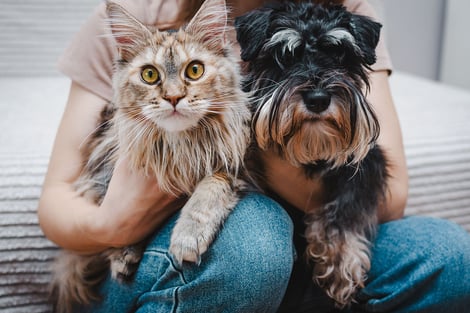7 Tips for Finding and Keeping Affordable Pets

Is there a way to adopt a pet for free? Are there affordable pets out there for people on fixed incomes?
Many people who want to share their lives with pets face uncertain financial situations that make them question whether they can afford to keep a pet. It can be important to understand the expense of getting a pet, and equally important, the cost of keeping your pet healthy. The most affordable pet is a healthy one that receives appropriate veterinary care before you decide to bring it home. The least affordable pet is an animal that hasn’t been to a vet in more than a year — or one that never had vet care.
Tips for Finding Affordable Pets
There are several ways that people bring pets into their household. Adopting or buying a pet are two popular ways to get a pet and usually involve paying money to take the bundle of joy home. Then there are the “free” options, which usually means you need to provide veterinary care to know what health problems exist so you know what you’re getting yourself into.
Here are some tips for finding a pet when you are living on a budget.
1. Adopt from Shelters and Rescues
Adopting a dog from a humane organization or shelter is often the most affordable way to pay for a pet. Pawlicy Advisor estimates that adopting a shelter puppy or dog can cost $50-$300. Animal shelters, humane societies, and rescues work to reduce the number of unwanted pets that lead to millions of animals being euthanized every year.
While shelters and rescues charge adoption fees, they usually include vaccinations, spaying/neutering, and microchipping.
For example, in Ohio, the Cuyahoga County Animal Shelter charges adoption fees of $95 for adult dogs and $170 for puppies under five months of age. This is much less than the cost of buying from a pet store. The dogs from this shelter already have had vaccinations for DHLP, parvo, rabies, and Bordetella. They’ve also been spayed or neutered, microchipped, and you even get a dog license for the current year.
To compare, getting a dog from a breeder or pet store can cost thousands. Pawlicy Advisor estimates that a purebred dog costs $500-$3,000. And we know that “designer breeds” can also cost as much as a purebred dog. Purebred dogs used to be the most expensive dogs you could get. Their papers are a guarantee that the genetics of the dogs are documented to be legitimate.
2. Consider an Adult Animal
Puppies and kittens are almost always more expensive than adult dogs and cats. Why? Raising a puppy can be a full-time job, while raising a kitten is usually less time-consuming. Puppies need lots of attention, potty training, and vet care. Kittens also need attention and vet care, but they usually pick up on litter training quickly. Puppies need to learn to behave well with other dogs, pets, and people. This is best accomplished under the advice of a professional trainer.
Veterinary care needs for healthy puppies and kittens are more costly than for healthy adult dogs and cats because puppies and kittens need a longer series of vaccinations to keep them protected from specific diseases. Also, to reduce the number of unwanted pets, it’s strongly advised to spay or neuter your pet early in life. These are surgical procedures, so they can be too expensive for those on a limited budget.
Adopting an adult dog can be more cost-effective, especially if they’ve already been vaccinated and spayed or neutered.
3. Avoid “Designer Breeds” or Popular Purebreds
Breeds that are in high demand or animals that are considered designer breeds are often more expensive. Depending on a variety of factors, breeders may need to apply for a license or register with the USDA.
Consider mixed breeds; they should be less costly, and they can make fantastic pets.
Designer breeds are typically a cross between one purebred dog and another purebred dog, such as a Labradoodle (a Labrador retriever mated with a poodle) or a Yorkie-Poo (a Yorkshire terrier mated with a poodle). People who sell these dogs may make claims that they’re healthier than purebred dogs, but that’s not always the case.
Any purebred dog will be expensive unless it has a genetic defect, such as a cleft lip and palate or bad hips. What you’re paying for in a purebred dog is the pedigree papers. Designer dogs and mixed-breed dogs don’t have pedigree papers.
One of the most important things for a potential pet parent to know is how to avoid buying a pet that came from a “puppy mill.” These are breeders who take advantage of the public’s desire for certain breeds and don’t provide appropriate care for the animals in their operations. They care more about making money and don’t realize that if they take better care of the dogs, they might be able to make more money since more puppies are born healthy and their survival rates increase.
Veterinarians often cringe when a new movie comes out with a specific dog breed, which too often encourages people to want one and makes them popular. Just because you see them on a TV show or in the movies doesn’t mean they make great pets for you and your household. Getting a dog breed that isn’t suitable can lead to problems for you, other household members, and the dog. You can use this AKC reference to determine if a purebred dog is right for you and your household.
4. Check Breed-Specific Rescues
If you are looking for a specific breed or mix, there are breed-specific rescues that take in dogs and help find homes for them. They often have adoption fees that are significantly lower than buying from a breeder or store.
5. Look on Local Classified and Online Platforms
Sometimes people need to rehome their pets because of life circumstances or because they are moving to a place where they can’t take their pet. You might find listings for animals for minimal cost. But proceed with caution. You should be sure you are dealing with a reputable source, and you need to learn all you can about the health and background of the animal.
6. Avoid Free Animals
If someone offers you a free dog, or if you find one on the streets, it’s possible they have serious health or behavioral problems that require expensive veterinary care. A free pet is not a free pet forever.
If you fall in love with a free animal and you want to keep that bundle of joy, make an appointment with a veterinarian as soon as possible and keep the animal away from your other household members until after the vet gives the OK.
7. Find Financial Assistance Programs
Help is available to make pet ownership more affordable. Some veterinarians offer free or low-cost spay/neuter programs and assistance programs like Veterinary Vouchers provided by One Health Organization that help low-income pet parents cover the cost of essential veterinary care. We believe that pets should live in loving homes rather than in a shelter, if possible.
The Cost of Keeping a Pet
Finding an affordable animal is important, but it’s equally important to consider the ongoing expense of keeping a pet like food, grooming, and veterinary care.
The cost of keeping a dog varies, depending on the size, age, and health of the dog. There is less of a range with cats since cats are about the same size as one another.
The cost of pet food is definitely going up, and there is a huge range in what people pay for food. You could pay $200-$7,000 a year to feed a 55-pound dog. But don’t fall for the marketing claims of companies making “premium,” expensive foods. The average healthy animal does well eating a commercially prepared food you can find at the supermarket.
When it comes to vet care, the American Veterinary Medical Association (AVMA) estimates that the average yearly cost of vet care for one dog increased from $224 in 2020 to $362 in 2022. The average cost of veterinary care for a cat jumped from $189 in 2020 to $321 in 2022. This is because some veterinarians hadn’t raised their prices to meet inflation, and the industry is finally increasing their prices so they can continue to run their businesses.
Unfortunately, when people delay essential veterinary care, they can sometimes end up spending more in the long run.
Do Your Homework
Living with a companion animal provides numerous mental and physical health benefits. And it is a long-term commitment. Before bringing home a new animal, it is important to do your research. You’ll need to
- Choose a reputable breeder or adopt from a shelter that provides veterinary care for their dogs before you get them (or gives you the option to take your new pet to your veterinarian before you commit to keeping the animal).
- Get a veterinarian's opinion about the current health of your animal as soon as possible.
- Get a health guarantee or contract that specifies what happens if the animal has health issues.
- Get a copy of their most recent health records from a veterinarian.
- Get their pedigree papers if you purchase a purebred dog or cat from a breeder (shelters and other rescues are unlikely to have these papers).
- Consider pet insurance, as it can help pay for unexpected veterinary costs. Get pet insurance before your pet has serious health conditions.
- Watch for potential health problems. If the animal seems to be acting or looking strange, that might be an indication that it has a serious health problem.
Your Veterinary Allies
Life is better when we share our lives and homes with pets. But too many people fall in love with the look of an animal without knowing the full cost and responsibility of caring for that animal over its lifetime.
Your veterinarian can be an important partner in helping you choose a pet that is right for your lifestyle and keeping that pet healthy for a lifetime of snuggles.

